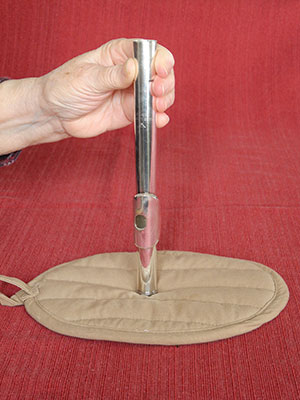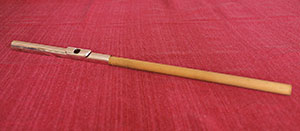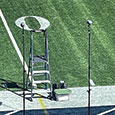One flutist told me that he swabbed his headjoint out about every thirty minutes when he was teaching and performing because he did not like the sound when there was moisture in it. I have not resorted to doing that yet, but I do wash the headjoint at least once a week because I like the sound of a clean headjoint. Many flutists wipe the headjoint with rubbing alcohol after a playing. This removes the slight layer of grease on the chin side of the embouchure plate and keeps it from slipping and sliding when playing the next day.
Popping the Crown
Taking the crown and cork assembly out of the flute is scary to many flutists. It need not be because there is nothing you can break if you follow these simple steps. To wash the headjoint out, remove the cork assembly. The first step in removing the cork assembly is to loosen the crown a few turns. This means turning the crown to the left a few times. Holding the headjoint at the tenon end, gently place the crown end on a pot holder or something soft and cushy that will protect the crown and table surface and then push down. This is called popping the crown. The cork assembly is now ready to be pushed through the headjoint towards the tenon end using a special ejection tool. You can make one of these yourself or a flute repairman will make one for you. This is the safest way to remove the cork assembly.


Popping the cork with the insertion tool.

Insertion tool
Inspect for Damage
Once the cork assembly is out, inspect the cork checking to see if it is dried out or pulling away from the plate. If it is damaged, then take the flute to a repair person for replacement. Also look at the plate that the cork is glued to for scratches, pock marks etc. These are caused by the end of the cleaning rod hitting the plate when drying the moisture from the headjoint. If it is highly pocked, then replace the stem assembly. This is not a high-priced item, and a new one may improve the sound and intonation. If there is any residue on the plate, clean it with a damp cloth. The stem assembly should certainly be switched out during an overhaul, but it may be switched out when having a COA (clean, oil, and adjust).
Wash the Headjoint
Next wash the headjoint in a mixture of Dawn dishwashing liquid (the kind you would use for washing dishes by hand) and warm water. I have a plastic cleaning rod that I place a silk scarf around to clean the inside. I use a plastic cleaning rod because it is not damaged when it gets wet. Be careful to not scratch the inside of the headjoint with the cleaning rod if you are using a metal one. While washing the headjoint (both inside and out), do not grasp the embouchure plate as this may loosen the solder or bend the lip plate. Rinse with warm water paying special attention to the inside of the riser or chimney. Dry the inside with a clean silk cloth and the outside with a smooth tea towel.
Back Together
Replace the cork assembly by dropping it into the tenon end of the headjoint. If it is fitted well, the plated end will be visible at the halfway point of the embouchure hole. A well-fitted cork will be tapered to fit the taper of the crown end of the headjoint. If it is cylindrically shaped, you may want to find a different flute repairman. A cork that is too tight and not tapered will be flat in pitch and have a dull sound. If your flute seems flat and dull in tone, replacing the cork assembly with one that is well-fitted may improve the sound of the flute. Use the cleaning rod to gently move the cork assembly towards the crown end of the headjoint. When the line on the cleaning rod is in the center of the embouchure hole, you are ready to screw the crown into place.
Next, I play the headjoint in. While this may be based on an old wives’ tale, I do find that the headjoint responds better after playing the headjoint in when I assemble the entire flute. To do this, I place my thumb and index fingers at the crown and tenon ends (under the headjoint) taking care to keep my fingerprints off the headjoint. Touch the headjoint as little as possible. Then I play slurred half-note octaves up and down many times with a forceful vibrato. I do this for about ten or so minutes. It is a great workout for the embouchure too. I want to get the metal in the headjoint vibrating as much as possible. Joseph Mariano, the legendary Eastman School of Music flute professor, cautioned me, “Don’t let anyone who doesn’t know how to blow play your flute.” I thought this was an unusual statement but have followed his advice. The results are so good when playing the headjoint in that as soon as you hear a negative difference in the sound in a few days, you may want to repeat the process starting with washing the headjoint out. When I first started this, I did it every few days, but now I can go about a week or so before the headjoint loses its ring. Even if this is a fictitious process, there is benefit to be had from playing slurred octaves on the headjoint. Try it before you pass judgment.
When playing on the headjoint, I follow Theobald Boehm’s advice to keep the embouchure hole level when blowing. This means that the embouchure muscles must be developed; however, the results are worth the extra practice because the high harmonics or upper partials are stronger in the tone, and the intonation is improved. When playing octaves on the headjoint, the octaves will not be in tune because of the parabolic shape of the headjoint closer to the tenon. However, this shape improves intonation when the flute is assembled.
A violin professor told me he can tell how a new student will play just by observing how he takes the violin and bow out of the case. I think this may be true for flutists also. Young students often put the flute together very quickly without carefully aligning the headjoint to the body’s tenon box. The goal is to keep the tenon end of the headjoint round. If you try to assemble the instrument without the two parts being carefully aligned the tenon will no longer be round. Take special care in putting the flute together as this will improve the overall ring of the instrument.
When playing with the flute assembled, keep your fingers off the headjoint and especially off the lip plate. I am not in favor of cleaning the fingerprints off the body and footjoint with alcohol as it is too easy to make a mistake and spoil a pad. The body and footjoint of my flute have some tarnish which I do not remove because to do it correctly and safely, all of the keys must be removed, and the flute secured before cleaning. A slightly tarnished flute is one that has been played and loved.
You may be fearful about taking the headjoint cork out of the flute, but you should not be. There is not anything that you can break if you take your time and have the proper tool. Playing on a clean headjoint is a treat.






